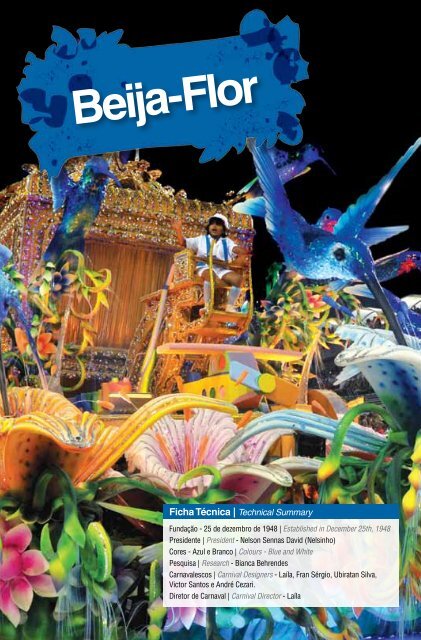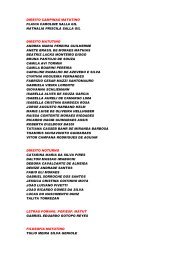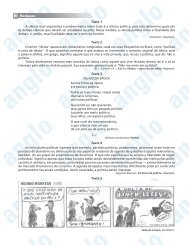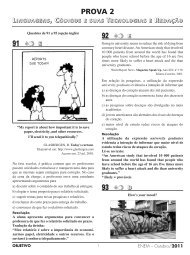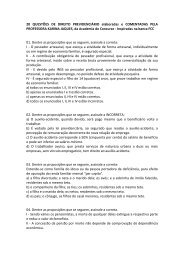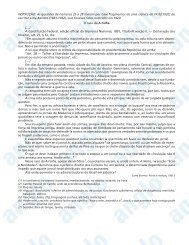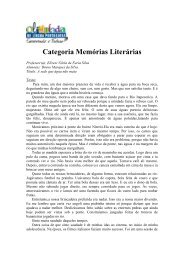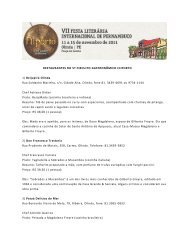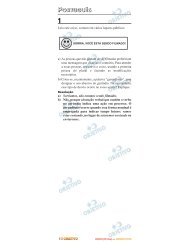Beija-Flor - Globo.com
Beija-Flor - Globo.com
Beija-Flor - Globo.com
You also want an ePaper? Increase the reach of your titles
YUMPU automatically turns print PDFs into web optimized ePapers that Google loves.
<strong>Beija</strong> <strong>Flor</strong><br />
<strong>Beija</strong>-<strong>Flor</strong><br />
Ficha Técnica | Technical Summary<br />
Fundação - 25 de dezembro de 1948 | Established in December 25th, 1948<br />
Presidente | President - Nelson Sennas David (Nelsinho)<br />
Cores - Azul e Branco | Colours - Blue and white<br />
Pesquisa | Research - Bianca Behrendes<br />
Carnavalescos | Carnival Designers - Laíla, Fran Sérgio, Ubiratan Silva,<br />
Victor Santos e André Cezari.<br />
Diretor de Carnaval | Carnival Director - Laíla
GRES <strong>Beija</strong>-<strong>Flor</strong> de Nilópolis<br />
6ª Escola - Entre 02h25 e 03h50<br />
6th School - Between 2:25am and 3:50am<br />
Concentração: Correios | Meeting Point: Post Office<br />
Sinopse do Enredo | Samba Theme Synopsis<br />
Upaon-Açu é solo sagrado, cobiçado por três Coroas.<br />
Colonizado por Portugal, a escravidão macula seus<br />
ares. Depois, surge <strong>com</strong>o terra mística, cultivada à<br />
força da oração, de onde vêm a alegria e o encanto<br />
das festas, dos mitos e lendas. A capital do<br />
Maranhão é terra de Alcione, de Joãozinho Trinta, de<br />
Zeca Baleiro, de Rita Ribeiro, do Reggae Brasileiro,<br />
de Gonçalves Dias, de Ferreira Gullar e Josué<br />
Montelo. É da folia do fofão, do vira-lata, do<br />
cruz-diabo, do corso do meretrício e das cabrochas e<br />
mascarados dos salões do Moisés. É, também, o<br />
Eldorado da bauxita, chama acesa a iluminar seu<br />
futuro, que irá consagrar São Luís <strong>com</strong>o a pérola<br />
sagrada da Coroa encantada do glorioso Maranhão.<br />
Upaon-Açu, an Island off the Northern state of<br />
Maranhão, is sacred ground coveted by three<br />
different kingdoms. Colonized by Portugal, slavery<br />
stained this idyllic place - later known as the land<br />
of mysticism. The power of prayer made the<br />
soil flourish once more, turning Upaon-Açu into<br />
an eternal source of joy and celebrations full of<br />
enchantments, myths and legends. The state capital<br />
of Maranhão is the birthplace of famous singers :<br />
Alcione, Joãozinho Trinta, Zeca Baleiro, Rita Ribeiro,<br />
Gonçalves Dias, Ferreira Goulart, Josué Montelo,<br />
as well as the Brazilian Raggae. It is the place of<br />
revelry for “fofão, vira-latas, cruz do diabo,” (literally<br />
translated as fluffy, street-dogs and devil’s cross),<br />
prostitutes from the red light district and the dark<br />
mulatto girls from Moses’ saloons. It is also the El<br />
Dorado of bauxite, which consecrated São Luis as<br />
the Jewel of the Enchanted Crown of Maranhão.<br />
Domingo<br />
Sunday<br />
A primeira punição da “genitália desnuda” sobre um<br />
<strong>com</strong>ponente “vivo” foi no carnaval de 1992 da <strong>Beija</strong><br />
<strong>Flor</strong>. Um sambista foi flagrado de frente: era “um<br />
ponto de luz na imensidão”. Este também era o nome<br />
do enredo da escola. Curiosamente a ”Tradição”<br />
neste ano veio <strong>com</strong> o enredo “O Espetáculo Maior”.<br />
A Enquanto isto, em desfile triunfal, a ala gay da<br />
Mocidade cantava: “Sonhar não custa nada...ou<br />
quase nada”. Pior foi a Santa Cruz que em seu<br />
enredo dizia “De Quatro em Quatro Eu Chego Lá”.<br />
Uma coisa!<br />
Fun Facts: The first penalty for parading live in<br />
the nude was given to <strong>Beija</strong>-<strong>Flor</strong> during the 1992<br />
Carnival. A reveler was photographed from the front:<br />
it was meant to be “a point of light in the wilderness”,<br />
which was also <strong>Beija</strong>-<strong>Flor</strong>’s samba theme. Curiously,<br />
for“Tradição” that year’s samba theme was called<br />
“The Greatest Show Ever.” Meanwhile, the gays<br />
at“Mocidade” sang “Dreaming is free… or practically<br />
Free.” The worst was Santa Cruz’s theme “Crawling I<br />
get There.” Quite something!
<strong>Beija</strong> <strong>Flor</strong><br />
Cante <strong>com</strong> a <strong>Beija</strong>-<strong>Flor</strong><br />
Sing along with <strong>Beija</strong>-<strong>Flor</strong><br />
EnrEdo: SÃO LUíS - O POEMA ENCANTADO<br />
DO MARANHÃO | Theme: “SÃO LUíS - THE<br />
ENCHANTED POEM OF MARANHÃO”<br />
Compositores | Songwriter: J. Velloso, Adilson<br />
China, Carlinhos do Detran, Silvio Romai, Hugo<br />
Leal, Gilberto Oliveira, Samir Trindade, Serginho<br />
Aguiar, Jr. <strong>Beija</strong>-<strong>Flor</strong>, Ricardo Lucena, Thiago Alves<br />
e Rômulo Presidente.<br />
Intérprete | Singer: Neguinho da <strong>Beija</strong>-<strong>Flor</strong><br />
Tem magia em cada palmeira que brota em seu chão<br />
O homem nativo da terra<br />
Resiste em bravura a dor da invasão<br />
Do mar vem três coroas<br />
Irmão seu olhar mareja<br />
No balanço da maré<br />
A maldade não tem fé sangrando os mares<br />
Mensageiro da dor<br />
Liberdade roubou dos meus lugares<br />
Rompendo grilhões, em busca da paz<br />
A força dos meus ancestrais<br />
na casa nagô a luz de Xangô axé<br />
Mina Jêje um ritual de fé<br />
Chegou de daomé, chegou de Abeokutá<br />
Toda magia do Vodun e do orixá<br />
Ê rainha, o bumbá meu boi vem de lá<br />
Eu quero ver o Cazumbá<br />
Sem a serpente acordar<br />
Hoje a minha lágrima transborda todo mar<br />
Fonte que a saudade não secou<br />
Ó Ana... assombração na carruagem<br />
Os casarões são a imagem<br />
Da história que o tempo guardou<br />
No rádio o reggae do bom<br />
Marrom é o tom da canção<br />
Na terra da encantaria a arte do gênio João<br />
Meu São Luís do Maranhão<br />
Poema encantado de amor<br />
onde canta o sabiá<br />
Hoje canta a <strong>Beija</strong>-<strong>Flor</strong>!<br />
A<strong>com</strong>panhe o Desfile | Parade Sequence<br />
1º SETor: A QuIMErA EuroPÉIA E o PArAÍSo<br />
dourAdo dEuPAon-Açu | 1st SeCTION: The<br />
ImPOSSIBLe DReAm OF eUROPe ANDThe GOLDeN<br />
PARADISe OF UPAON-AÇU<br />
CoMISSÃo dE FrEnTE: A SERPENTE<br />
ENCANTADA E OS GUERREIROS TUPINAMBÁS<br />
NA ILHA DE UPAON-AÇU | hONORAY<br />
COmmITTee: THE BIG ISLAND, THE ENCHANTED<br />
SERPENT AND THE TUPINAMBAS wARRIORS<br />
CorEóGrAFo | ChOReOGRAPheR:<br />
FÁBIO DE MELLO<br />
A Lenda da Serpente Encantada estava na mente<br />
dos Tupinambás, guerreiros temerosos de que se<br />
tornasse realidade e afundasse Upaon-Açu, a “Ilha<br />
Grande”... | The Legend of the Enchanted Serpent<br />
lived in the mind of theTupinambás, indigenous<br />
warriors tribe that feared it would turn into<br />
realityand sink the Upaon-Açu, the “Big Island”...<br />
1º CASAL MESTrE-SALA E PorTA-BAndEIrA<br />
1st mASTeR OF CeRImONY AND FLAG BeAReR<br />
COUPLe: SELMyNHA SORRISO E CLAUDINHO<br />
FAnTASIA: A TERRA MARAVILHA DOS<br />
TUPINAMBÁS | COSTUme: THE wONDERFUL<br />
LAND OF TUPINAMBAS<br />
Os ancestrais Tupinambás são os guerreiros,<br />
detentores das origens, das raízes e das<br />
verdadeiras riquezas da tribo dos homens nus.<br />
The ancestors Tupinambás are the warriors,<br />
keepers of the origins, the roots and the true<br />
wealth of the tribe of naked men.
1ª ALA: INDOMÁVEIS CORPOS NUS TUPINAMBÁS<br />
1st WING: wILD AND NAKED TUPINAMBÁS<br />
A cidade de São Luís, a Upaon-Açu, era habitada<br />
por indígenas. Centenas de Tupinambás lá viviam<br />
e resistiram <strong>com</strong> bravura às invasões estrangeiras.<br />
The city of São Luis was inhabited by indigenous<br />
tribes. Hundreds of those who lived there fought<br />
bravely the foreign invasions.<br />
2ª ALA: TRÊS COROAS EM MARES DE AMBIÇÃO<br />
2nd WING: THREE KINGDOMS SwIMMING<br />
IN AMBITION<br />
França, Holanda e Portugal cruzaram os mares<br />
pela cobiça e pela ambição: São Luís foi fundada<br />
por franceses, invadida por holandeses e<br />
colonizada por portugueses. | Motivated by wealth<br />
and ambition, France, Holland and Portugal crossed<br />
the ocean and invaded the state of Maranhão. São<br />
Luis was established by the French, invaded by the<br />
Dutch and settled by the Portuguese.<br />
1º CArro ABrE-ALAS: A QUIMERA EUROPEIA E O<br />
IMAGINÁRIO PARAíSO DOURADO DE UPAON-AÇU<br />
OPeNING FLOAT: EUROPE’S IMPOSSIBLE DREAM<br />
AND THE BIG GOLDEN PARADISE ISLAND<br />
As três Coroas europeias vieram para o chamado<br />
Novo Mundo para encontrar o que imaginavam<br />
ser uma terra feita de ouro puro, repleta de pedras<br />
preciosas. | Three European Crowns arrived in the<br />
New world looking for a land of pure gold and full or<br />
precious stones.<br />
2º SETor | 2nd SeCTION<br />
Domingo<br />
Sunday<br />
3ª ALA: FASCINANTE TERRA DAS PALMEIRAS<br />
3rd WING: THE FASCINATING LAND OF PALM TREES<br />
Os colonizadores imaginavam que as palmeiras<br />
eram feitas de ouro. De tão presentes no território<br />
maranhense, são mencionadas no poema de<br />
Gonçalves Dias:“Minha terra tem palmeiras onde<br />
canta o sabiá”. | Settlers imagined the palm trees<br />
were made out of gold. There were so many of these<br />
trees in Maranhão that our poet Gonçalves Dias<br />
praised them in verse: “My land has palm trees on<br />
which the robins sing”.<br />
4ª ALA: ESCRAVA NOBREZA<br />
4th WING: NOBLES BECOME SALVES<br />
O tráfico de negros africanos subjugou reis,<br />
rainhas, príncipes e princesas a um destino atroz:<br />
belos, livres e bravos, tornaram-se escravos,<br />
atuando <strong>com</strong>o braços para erguer a cidade de<br />
São Luís. | The traffic of black slaves from Africa<br />
subdued queens, princes and princesses to a cruel<br />
destiny: beautiful, free and brave they became slaves<br />
and were included in the work force to build the city<br />
of São Luis.<br />
5ª ALA: ANGúSTIA DOS GRILHõES<br />
5th WING: THE ANGUISH OF THE SHACKLES<br />
Malfeitores escravocratas promoveram<br />
atrocidades contra os negros vindos da África.<br />
Ruthless Europeans perpetrated atrocities against the<br />
blacks that came from Africa.<br />
2º CArro A: LAMENTOS DE DOR NO BALANÇO<br />
DA MARÉ | 2nd FLOAT A: LAMENTS OF PAIN SwAY<br />
ON THE SEA<br />
Milhares de negros foram trazidos da África para<br />
povoar e colonizar São Luís. Seus corpos foram<br />
escravizados, mas suas mentes, seus espíritos e sua fé<br />
se mantiveram livres. | Thousands of blacks came from<br />
Africa to settle and colonize São Luis. Their bodies were<br />
enslaved but NOT their minds, spirits and faith.<br />
6ª ALA: O MERCADO DE DIALETOS AFRICANOS<br />
6th WING: A MARKET OF AFRICAN DIALECTS<br />
A farta mão-de-obra escrava em São Luis fez<br />
<strong>com</strong> que houvesse uma diversidade de dialetos<br />
africanos usados pelos que alavancaram e<br />
construíram a cidade. | Abundant slave work force<br />
in São Luis brought along a variety of dialects with<br />
those who worked hard to build the city.
<strong>Beija</strong> <strong>Flor</strong><br />
2º CArro B: O TRÁFICO NEGREIRO EM NAVIOS<br />
TUMBEIROS | 2nd FLOAT B: SLAVE TRAFFIC IN<br />
TOMB SHIPS<br />
Os navios negreiros eram chamados de tumbeiros<br />
porque escravos feridos morriam ao longo do<br />
percurso, devidos às péssimas condições de viagem.<br />
The ships bringing the slaves from Europe were called<br />
tomb ships as the slaves died during the course of the<br />
journey due to the poor conditions on board.<br />
3º SETor: SAnTuÁrIo MÍSTICo dE dEVoçÃo -<br />
o SAGrAdo E o ProFAno EM unIÃo<br />
3rd SeCTION: A mYSTIC SANCTUARY OF DevOTION -<br />
The eNCOUNTeROF The SACReD AND The PROFANe<br />
7ª ALA: FESTA DO DIVINO - POVO SANTO EM<br />
ORAÇÃO | 7th WING: CELEBRATING THE DIVINE -<br />
HOLY PEOPLE IN PRAYER<br />
O culto ao Divino Espírito Santo veio <strong>com</strong><br />
colonizadores portugueses no século XVII e<br />
até hoje se realiza nas casas de culto africano,<br />
sendo universal a presença da Pomba e de cores<br />
vivas. | The devotion to the Holy Spirit is part of the<br />
Portuguese legacy from the XVII century preserved<br />
in African cults and universally represented by a dove<br />
and the bright colors.<br />
8ª ALA: SÃO MARÇAL - FESTEJO SANTO<br />
8th WING: SÃO MARÇAL - CELEBRATING A SAINT<br />
O festejo de São Marçal acontece em São Luís há<br />
mais de 80 anos, quando os grupos de Bumba-<br />
Meu-Boi da Ilha <strong>com</strong>eçaram a se reunir na Praça<br />
Ivar Saldanha. | The saint has been celebrated in São<br />
Luis for over 80 years when groups of “Bumba-<br />
Meu-Boi* da Ilha” started to meet at the Praça<br />
Ivar Saldanha. *Bumba Meu Boi is a Brazilian folk<br />
theatrical tradition - tale told through music,<br />
costumes and drumming - that involves a Bull.<br />
2º CASAL MESTrE-SALA E PorTA-BAndEIrA<br />
2nd mASTeR OF CeRImONY AND FLAG BeAReR<br />
COUPLe: DAVID SABIÁ E JANAILCE ADJANE<br />
FAnTASIA: BICO-BILICO - SANTINHO ASSANHADO<br />
COSTUme: BICO-BILICO A COOL LITTLE SAINT.<br />
9ª ALA: SÃO BILIBEU - O SANTINHO DO BREU<br />
9th WING: “SÃO BILIBEU - THE LITTLE SAINT<br />
OF DARKNESS<br />
São Bilibeu protege os bichos de casa, doentes ou<br />
perdidos.Difundido no Maranhão, acredita-se que<br />
seja milagreiro. | São Bilibeu is the patron saint of<br />
the home, the sick and the lost pets. In Maranhão,<br />
the belief is that he works miracles.<br />
10ª ALA: O CORTEJO DE DOM SEBASTIÃO<br />
10th WING: PROCESSION OF DOM SEBASTIAN<br />
Diz a lenda maranhense que, nas noites de São<br />
João, o fantasma do rei português Dom Sebastião<br />
retorna à praia. | The legend claims that in evenings<br />
of Saint John’s celebrations the ghost of Dom<br />
Sebastian returns to the beach.<br />
11ª ALA: DOM LUíS - O ENCANTADO REI DE<br />
FRANÇA | 11th WING: DOM LUIS - THE CHARMING<br />
KING OF FRANCE<br />
Dentre os “encantados”, referência às entidades<br />
de pajelança afro-ameríndia, destaca-se a figura<br />
dosoberano francês Luís XIII, inspiração para o nome<br />
da capital do Maranhão. | The king of France Luis<br />
XIII is one of the various enchanted Afro-Amerindian<br />
entities of shamanism. São Luis, the state capital of<br />
Maranhão, is named after him.<br />
3º CASAL dE MESTrE-SALA E PorTA-BAndEIrA<br />
3rd mASTeR OF CeRImONY AND FLAG BeAReR<br />
ANDREZINHO E NANINHA FIDELLyS<br />
FAnTASIA: TODA A MAGIA DO VODUN<br />
COSTUme: ALL MAGIC IN VODUN
12ª ALA: A ESSÊNCIA DOS RITUAIS VODUNS<br />
12th WING: THE ESSENCE OF VODOUNS RITUALS<br />
O vodun (Divindade de origem Ewe/Fon) é tradição<br />
religiosa, difundida <strong>com</strong> a importação de escravos<br />
africanos. No Maranhão, o culto aos voduns<br />
acontece na Casa das Minas. | Vodun is a religious<br />
tradition that reached Brazil with Slavery. In<br />
Maranhão it is perpetuated in the “Casas de Minas”<br />
(cult spaces).<br />
dESTAQuE dE CHÃo | GROUND hIGhLIGhT:<br />
JAQUELINE FARIA<br />
FAnTASIA: AGOTIMÉ - A RAINHA FEITICEIRA<br />
COSTUme: AGOTIMÉ - wITCH QUEEN<br />
A pantera negra é o símbolo totêmico do vodun<br />
daometano, e simbolizava a rainha Agotime. | The<br />
black jaguar is the totemic symbol of the daometan<br />
vodun (voodoo) and represents Queen Agothime.<br />
13ª ALA: RITUAL DE FÉ DA RAINHA AGOTIMÉ<br />
13th WING: THE DEVOTION RITUAL OF<br />
QUEEN AGOTIMÉ<br />
Nã Agotimé, negra Mina rainha do Daomé, fundou,<br />
em São Luís, no século XIX, a Casa das Minas ou<br />
Querebentã de Toy Zomadonu, a qual dedica-se<br />
ao culto Jeje dos voduns. | Nã Agotimé is a black<br />
queen of Dahomey in Africa who, in the 19th century,<br />
established in São Luis cult spaces or “Casas de<br />
Minas” also called Querebentã de Toy Zomadonu<br />
where Jeje vodun ceremonies took place.<br />
14ª ALA: MENSAGEIROS ESPIRITUAIS<br />
14th WING: SPIRITUAL MESSENGERS<br />
Em São Luís do Maranhão, onde o sincretismo<br />
religioso é expressivo, são numerosas as casas<br />
de culto, onde médiuns exercem a função de<br />
mensageiros espirituais. | In São Luis, where<br />
syncretism has many followers, clairvoyants who<br />
perform as spiritual messengers are numerous.<br />
3º CArro: SANTUÁRIO MíSTICO DE DEVOÇÃO<br />
3rd FLOAT: SANTUARY OF MYSTICISM<br />
AND DEVOTION<br />
O sincretismo se faz presente nos costumes<br />
populares: no batuque, na reza forte, nos voduns e<br />
nos orixás; nos tambores de Daomé, no candomblé,<br />
na Casa de Nagô e na Casa das Minas. | Syncretism<br />
is part of peoples’ daily life; it is felt in the percussion<br />
rhythm, powerful prayers, Voodoo cults, Dahomey<br />
drums, candomble, and voodoo temples known as<br />
Casas de Minas or Casa de Nagô.<br />
4º SETor: BuMBA-MEu-BoI – o EnCAnTo<br />
dASFESTIVIdAdES QuE EnFEITAM SÃo LuÍS<br />
4th SeCTION: BUmBA-meU-BOI – The<br />
CeLeBRATION’S SPeLL BRIGhTeNS The FACe<br />
OF SãO LUIS<br />
Domingo<br />
Sunday<br />
15ª ALA: O BAILAR DO TAMBOR DE CRIOULA<br />
15th WING: DANCE OF THE CREOLE DRUMS<br />
O Tambor de Crioula é uma dança africana praticada<br />
no Maranhão, principalmente por descendentes de<br />
escravos, em louvor à São Benedito.<br />
“Creole Drums” is a dance originated in Africa and<br />
made popular in Maranhão mainly by the slaves in<br />
tribute to São Benedito.<br />
16ª ALA: NA EXPLOSÃO DOS FOLGUEDOS<br />
16th WING: FOLKLORE CELEBRATIONS IN<br />
PROFFUSION | Nos festejos, resplandecem a vida<br />
das tradições e a beleza dos folguedos, repletos de<br />
música, canto, dança, cor e poesia, preenchendo o<br />
calendário cultural de São Luís. | The celebrations<br />
that to fill the cultural agenda of São Luis,enhance<br />
the beauty of local traditions with music, songs,<br />
dances, color and poetry.<br />
17ª ALA: FOLCLORE MULTICOR<br />
17th WING: MULTIFACETED FOLKLORE<br />
(BAIANAS | wHIRLING LADIES)<br />
As Baianas desfilam vestidas <strong>com</strong> renda de palha<br />
de buriti, rodopiando e balançando dezenas de<br />
fitas coloridas a exibir toda a pluralidade, beleza e<br />
magia do folclore de São Luís. | Traditional Baiana<br />
Ladies parade in lace and buriti straw, whirling<br />
their costumes and shaking colorful ribbons to<br />
display the multifaceted charm and beauty of São<br />
Luis folklore.
<strong>Beija</strong> <strong>Flor</strong><br />
MuSA dAS PASSISTAS | SAmBA DANCeR’S mUSe<br />
CHARLENE VALNICE<br />
FAnTASIA: FORMOSURA DE MUITAS CORES<br />
COSTUme: A BEAUTY OF MANY COLORS<br />
18ª ALA: BUMBA-MEU-BOI ME FAZ DANÇAR<br />
18th WING: BUMBA- MEU- BOI INSPIRES ME TO<br />
DANCE (PASSISTAS | SAMBA DANCERS)<br />
No mês de junho, a festa do Bumba-Meu-Boi é<br />
uma tradição que mistura de sons, emoções e<br />
cores, que <strong>com</strong>põem um espetáculo fascinante.<br />
June traditions of Bumba-Meu-Boi blend sounds,<br />
emotions and colors producing the most<br />
fascinating show.<br />
InTÉrPrETE: NEGUINHO DA BEIJA-FLOR<br />
FAnTASIA: O AMO CANTADOR<br />
COSTUme: THE MASTER SINGER<br />
rAInHA dE BATErIA | QUeeN OF The<br />
PeRCUSSION: RAíSSA OLIVEIRA<br />
FAnTASIA: SUBLIME ARTE SECULAR DO<br />
BORDADO | COSTUme: EMBROIDER: NOBEL AND<br />
SECULAR EXPRESSION OF ART<br />
19ª ALA: O SOTAQUE COLORIDO<br />
19th WING: A COLORFULL TRADITION<br />
(BATERIA | PERCUSSION)<br />
Sotaque é o estilo dos grupos folclóricos da tradição<br />
do Bumba-Meu-Boi. Na <strong>Beija</strong>-<strong>Flor</strong>, o sotaque<br />
maranhense será representado pelo ritmo preciso<br />
e pelo vigor da bateria nilopolitana. | Sotaque are<br />
styles adopted by the different groups of the Bumba<br />
Meu Boi folklore tradition. <strong>Beija</strong>-<strong>Flor</strong> represents<br />
Maranhão’s style, or “sotaque”, with a precise and<br />
vigorous performance by its percussion.<br />
20ª ALA: O FLORESCER DAS FESTAS JUNINAS<br />
20th WING: THE BOOMING OF JUNE CELEBRATIONS<br />
Nas festas juninas de São Luís, as matracas,<br />
as zabumbas e a orquestra ditam o ritmo que<br />
a<strong>com</strong>panham as dezenas de grupos de Bumba-Meu-<br />
Boi. | Matracas, zabumbas and the orchestra set the<br />
rhythm play of dozens of Bumba-Meu - Boi groups.<br />
21ª ALA: PAI FRANCISCO E MÃE CATIRINA ENTRAM<br />
NA RODA | 21st WING: FATHER FRANCISCO AND<br />
MOTHER CATRINA SIGN AND DANCE<br />
Mãe Catirina, grávida, deseja <strong>com</strong>er a língua do boi<br />
e Pai Francisco mata um boi de estimação de seu<br />
senhor. Depois, o boi ressuscita e há a festa para<br />
<strong>com</strong>emorar o milagre. | A pregnant Mother Catirina<br />
craves for ox tongue and Father Francisco kills his<br />
master’s beloved ox. The ox resurrects and they<br />
throw a party to celebrate the miracle.<br />
22ª ALA: O COLORIDO DA SINHAZINHA DO BOI<br />
22nd WING: THE YOUNG LADY OF BUMBA-MEU-BOI<br />
A festa do Bumba-Meu-Boi é uma tradição que<br />
se mantém desde o século XVIII, arrastando<br />
maranhenses e visitantes para brincar nos arraiás<br />
espalhados por São Luís. | Bumba-meu-boi is a<br />
tradition remaining from the 18th century that almost<br />
<strong>com</strong>pulsively attracts loads of locals and visitors to<br />
revelry spots all over São Luis.<br />
23ª ALA: VEM BRINCAR NESSE ARRAIÁ<br />
23rd WING: COME AND JOIN THIS REVELRY<br />
A Cia. Barrica do Maranhão, do bairro da Madre<br />
Deus, abrange diversas formas de expressão artística,<br />
tais <strong>com</strong>o o canto, a dança, a música, a literatura,<br />
o artesanato e o teatro de rua. | The art enterprise<br />
“Barrica do Maranhão” located in the neighborhood<br />
of Madre Deus’ include the various forms of artistic<br />
expressions such as singing, dancing, music,<br />
literature, handcrafts and street theater.<br />
24ª ALA: A SENSUALIDADE ORQUESTRADA<br />
24th WING: wELL MANAGED SENSUALITY<br />
O Bumba-meu-Boi de Nina Rodrigues foi criado por<br />
Concita Braga e apresenta um elenco de belíssimas<br />
índias. | Bumba-Meu-Boi de Nina Rodrigues was<br />
conceived by Concita Braga and features a cast of<br />
beautiful Brazilian Indian women.
25ª ALA: A VIBRAÇÃO DAS TOADAS<br />
25th WING: THE VIBES OF FOLK SONGS<br />
O Grupo Folclórico Bumba-Meu-Boi de Axixá,<br />
fundado em 1959 por Francisco Neiva, irradia<br />
talento, beleza e alegria, apresentando belos trajes e<br />
coreografias bem executadas.<br />
Folklore group Bumba-Meu-Boi from Axixá,<br />
established in 1959 by Francisco Neiva, engulfs<br />
people with beauty, joy, amazing costumes and wellperformed<br />
choreographies.<br />
26ª ALA: EU QUERO VER CAZUMBÁ<br />
26th WING: I wANT TO SEE CAZUMBÁ<br />
A Associação Cultural do Bumba-Meu-Boi e Tambor<br />
de Crioula Unidos de Santa Fé foi fundada em<br />
1988, sob coordenação dos boieiros José de Jesus<br />
Figueiredo – o popular ‘’Zé Olhinho’’,<br />
Bumba-Meu-Boi de Unidos de Santa Fé, established<br />
by Zé Olhinho, Raimundo Miguel Ferreira and João<br />
Madeira Ribeiro was consecrated as the “Brazilian<br />
Diamond”.*cazumbá is a hybrid, mysterious haunted<br />
character of Bumba-Meu-Boi<br />
27ª ALA: BATALHÃO PESADO<br />
27th WING: DANCING IN THE BRAVE wARRIOR’S<br />
AwARD | O Bumba-Boi da Maioba, de Sotaque da<br />
Ilha, tem um jeito festivo de <strong>com</strong>emorar o São João,<br />
“botando o boi na rua” para homenagear o Santo,<br />
<strong>com</strong> os “maiobeiros”. | The Boi-Bumba of Maioba,<br />
Accent Island, is a festive way to celebrate “São<br />
João”, “putting the ox in the street” to honor the<br />
Santo, with “maiobeiros.”<br />
Domingo<br />
Sunday<br />
28ª ALA: BATALHÃO DE OURO<br />
28th WING: BATTALION OF GOLD<br />
O Bumba-Boi de Maracanã, de Sotaque da Ilha,<br />
é uma <strong>com</strong>unidade centenária localizada na<br />
periferia de São Luís (MA). É um dos maiores e<br />
mais conhecidos conjuntos tradicionais do Estado<br />
do Maranhão. | The Boi-Bumba Maracana, Accent<br />
Island, Centennial is a <strong>com</strong>munity located on the<br />
outskirts of São Luís (MA). One of the largest and<br />
best known of traditional state of Maranhao.<br />
29ª ALA: DIAMANTE BRASILEIRO<br />
29th WING: BRAZILIAN DIAMOND<br />
Composto por ricos personagens <strong>com</strong>o os Rajados,<br />
o Bumba-Meu-Boi Unidos de Santa Fé ganhou<br />
destaque na história do folclore do Maranhão e do<br />
Brasil, sendo aclamado “Diamante Brasileiro”.<br />
Bumba-Meu-Boi de Unidos de Santa Fé, established<br />
by Zé Olhinho, Raimundo Miguel Ferreira and<br />
João Madeira Ribeiro was consecrated as the<br />
“Brazilian Diamond”.<br />
4º CArro: BUMBA-MEU-BOI – O ENCANTO DAS<br />
FESTIVIDADES QUE ENFEITAM SÃO LUíS<br />
4th FLOAT: “BUMBA-MEU-BOI” - THE CHARM OF<br />
FESTIVALS ADORNING SÃO LUIS<br />
A cultura ludovicense é um dos berços das<br />
expressões artísticas do Maranhão, destacando-se o<br />
Bumba-meu-boi. Nesta alegoria, há 60 <strong>com</strong>ponentes<br />
do Boi de Morros, respeitado grupo coordenado pela<br />
Família Lobato.<br />
São Luis is the cradle of art expressions in Maranhão<br />
- Bumba-Meu-Boi being the most important of them.<br />
In this category there are 60 <strong>com</strong>ponents <strong>com</strong>ing<br />
from “Boi dos Morros” under the management of<br />
Familia Lobato.<br />
5º SETor | 5th SeCTION<br />
30ª ALA: A MALDIÇÃO DO PALÁCIO DAS LÁGRIMAS<br />
30th WING: THE CURSE OF THE PALACE OF TEARS<br />
Na rua 13 de Maio, em frente à Igreja de São João,<br />
havia um casarão de três pavimentos.Diz-se que foi<br />
amaldiçoado e o sobrado passou a ser o Palácio<br />
das Lágrimas.<br />
On the street “13 de Maio”, accross the road from São<br />
João’s Church, there was a three floors old house. It<br />
was known for having been cursed and since it has<br />
been named the Palace of Tears.
<strong>Beija</strong> <strong>Flor</strong><br />
31ª ALA: A LENDA DA PRAIA DO OLHO D´ÁGUA<br />
31st WING: THE SPRING wATER BEACH LEGEND<br />
Diz a lenda que das lágrimas da filha do chefe<br />
indígena Itaporama surgiram duas nascentes<br />
que até hoje correm para o mar, as quais deram<br />
origem à Praia do Olho D’Água. | According to a<br />
legend, from the tears of the Indian chief Itaporama’s<br />
daughter, two water springs appeared. Thus thename<br />
to one of São Luis beaches’, Praia does Olho D’Água.<br />
“Beach of the watery Eye”.<br />
32ª ALA: NA PONTA DA AREIA, INÁ PRINCESA<br />
32nd WING: PRINCESS INÁ IN THE PONTA DE<br />
AREIA BEACH<br />
Lendas e mistérios povoam o imaginário popular<br />
maranhense, e dentre eles destaca-se a narrativa<br />
fantasiosa de Iná, a Princesa das Águas, que habita<br />
um castelo na Praia Ponta D’Areia.<br />
Many legends inhabit the popular imagination of the<br />
locals of Maranhão, among them thelegend of Iná,<br />
the princess of waters,who lives in the castle on the<br />
Ponta de Areia beach.<br />
33ª ALA: A SERPENTE ENCANTADA<br />
33rd WING: THE ENCHANTED SERPENT<br />
Acredita-se que há partes do corpo de uma Serpente<br />
Encantada no subsolo da cidade. Diz-se que a cauda<br />
e a cabeça do monstro se encontrarão um dia e a<br />
serpente abraçará a ilha, afundando-a.<br />
It is <strong>com</strong>mon belief that parts of the Enchanted<br />
Serpent lie beneath the surface of the city. According<br />
to the legend the head and the tale of the monster<br />
will eventually get together and the serpent will give a<br />
hug of death sinking the Island of São Luis.<br />
34ª ALA: A VITÓRIA LUSITANA E O MILAGRE DE<br />
GUAXENDUBA | 34th WING: LUSO VICTORY AND<br />
GUAXENDUBA’S MIRACLE<br />
No <strong>com</strong>bate entre portugueses e franceses em São<br />
Luís, diante do Forte de Santa Maria de Guaxenduba,<br />
diz-se que uma mulher, envolta em auréola<br />
resplandecente teria transformado a areia e os<br />
seixos, em projéteis. | Another <strong>com</strong>mon belief is that<br />
while Portuguese and French were in <strong>com</strong>bat, right in<br />
front of the fortress of Santa Maria de Guaxenduba,<br />
a lady encircled by a shining halo, transformed the<br />
rocks of the beach sand into missiles.<br />
35ª ALA: CRIMES OCULTOS PELA MANGUDA<br />
35th WING: MANGUDA’S HIDDEN CRIMES<br />
No final do século XIX, a “Manguda” assombrava<br />
a cidade. Mais tarde, descobriu-se que era uma<br />
fraude, criada por contrabandistas para esvaziar as<br />
ruas enquanto <strong>com</strong>etiam seus delitos. | In the end<br />
of the 19th century the ghost “Manguda” haunted the<br />
city. Later on it was discovered that the ghost was a<br />
fraud created by the smugglers to get people out of<br />
the streets while they were free to act illegally.<br />
36ª ALA: ANA JANSEN - ASSOMBROSA TIRANIA<br />
36th WING: ANA JANSEN - AMAZING TYRANNY<br />
Ana Joaquina Jansen Pereira ficou conhecida na cidade<br />
pela forma desumana <strong>com</strong> que tratava seus escravos.<br />
Mesmo depois de mortos, eles assombravam as noites<br />
de São Luís no século XIX. | Ana Joaquina Jansen<br />
Pereira was notorious for treating slaves with cruelty.<br />
After dying, the slaves came to haunt the nights of São<br />
Luis during the 19th century.<br />
5º CArro: O INVEROSSíMIL IMAGINÁRIO<br />
LUDOVICENSE | 5th FLOAT: THE INCREADIBLE<br />
IMAGINATION OF THE POPULATION OF SÃO LUIS<br />
Lendas povoam o imaginário popular em São Luís<br />
e não poderiam faltar contos de assombrações,<br />
favorecidos até mesmo pela própria geografia da<br />
cidade. | Favored by the geography of the city, the<br />
imagination of the people of São Luis is rich in<br />
haunted themes.
6º SETor | 6th SeCTION<br />
37ª ALA: HUMANO PATRIMÔNIO IMORTAL<br />
37th WING: IMMORTAL HUMANISTIC LEGACY<br />
São Luís, berço de artistas, terra de poetas e<br />
prosadores, é uma vitrine literária do país. Creditase<br />
à cidade a fama de ser onde se fala e se escreve<br />
o melhor português do Brasil.<br />
São Luis is the cradle of many artists, poets and<br />
literates. It is considered a Brazilian cultural display,<br />
known for being the best written and spoken<br />
Portuguese in the country.<br />
38ª ALA: SÃO LUIS TRADUZIDO EM OBRAS<br />
LITERÁRIAS | 38th WING: “SÃO LUIS TRANSLATED<br />
IN LITERARY wORK<br />
São Luís do Maranhão é cantada em verso e prosa<br />
<strong>com</strong>o a Ilha do Amor, Atenas Brasileira, Cidade dos<br />
Azulejos, Capital Brasileira da Cultura...<br />
São Luis do Maranhão is sung in verse and prose as<br />
the Island of Love, the Brazilian Athens, a city of tile<br />
art work, the Brazilian cultural center and more …<br />
39ª ALA: A ORALIDADE PRESERVADA EM CORDEL<br />
39th WING: CORDEL KEEPS THE ORAL<br />
TRADITION ALIVE<br />
A Literatura de Cordel é um gênero literário popular<br />
escrito na forma rimada, originado em relatos orais<br />
e impresso em folhetos. ainda encontrados até<br />
hoje, pelas ruas e feiras de São Luís. | The popular<br />
literary rhyming gender of Cordel (string literature)<br />
is kept alive by the word of mouth on the streets and<br />
market leaflets still in existence in São Luis.<br />
40ª ALA: ATENAS VERDE E AMARELA<br />
40th WING: ATHENS IN BRAZILIAN NATIONAL<br />
COLORS | Assim <strong>com</strong>o Atenas, na Grécia, foi centro<br />
intelectual na Antiguidade, São Luís foi considerada<br />
“Atenas Brasileira” pelo fato de seus nobres<br />
enviarem os filhos à Europa para estudar.<br />
In the same way Greece was the cultural center in<br />
the ancient times, so was São Luis for concentrating<br />
intellectuals who left to study in Europe.<br />
41ª ALA: RADIOLA NO TERREIRO - A JAMAICA<br />
POPULAR | 41st WING: “OUD RECORDED MUSIC<br />
PLAYED IN THE BACKYARD – A TREND IN JAMAICA<br />
O Reggae é um gênero musical popular que se<br />
espalhou pelo mundo, invadindo também o Estado<br />
do Maranhão. | The worldwide known Raggae also<br />
conquered the State of Maranhão.<br />
Domingo<br />
Sunday<br />
42ª ALA: NO RÁDIO O REGGAE DO BOM<br />
42nd WING: THE GODNESS RAGGAE<br />
O Reggae é um gênero musical que surgiu na<br />
Jamaica, influenciado pelo Movimento Rastafári.<br />
Firmou-se em São Luís, o embalando os amantes<br />
de boa música. | All the way from Jamaica, Raggae<br />
influenced the Rastafari Movement also popular in<br />
São Luis being a source of pleasure for lovers of<br />
good music.<br />
6º CArro: ATENAS BRASILEIRA E JAMAICA<br />
BRASILEIRA: OS EPíTETOS DE UM CELEIRO DE<br />
GRANDES ARTISTAS | 6th FLOAT: BRAZILIAN<br />
ATHENS AND BRAZILIAN JAMAICA: THE EPITHETS<br />
OF A BARN GREAT ARTISTS<br />
São Luís, terra descrita em versos por poetas,<br />
escritores, acadêmicos, letrados anônimos e<br />
famosos, é um berço de artistas; uma grande vitrine<br />
literária do país. | Notorious and unknown literates<br />
have described São Luis, in verse and prose; it is the<br />
cradle of many artists. The great display of Brazilian<br />
literature.<br />
7º SETor | 7th SeCTION<br />
43ª ALA: VIRA-LATAS PELOS BECOS COLONIAIS<br />
43rd WING: STREET DOGS AND COLONIAL ALLEYS<br />
O Vira-Latas é um antigo bloco maranhense, criado<br />
em 1933, por um grupo de cerca de 15 cadetes.<br />
“Mutts” is the name of a traditional street carnival<br />
group from Maranhão - established in 1933 by a<br />
groupof 15 cadets.
<strong>Beija</strong> <strong>Flor</strong><br />
44ª ALA: FOLIõES PELAS RUAS E SALõES<br />
44th WING: REVELERS ON THE STREET AND<br />
BALL ROOMS<br />
Os Blocos Tradicionais são grupos caracterizados<br />
por um ritmo próprio e fantasias luxuosas,<br />
confeccionadas <strong>com</strong> tecido estampado.<br />
Traditional street carnival groups have their own<br />
rhythm and luxury costumes made with colorful<br />
printed fabric.<br />
45ª ALA: CRUZ CREDO DIABO<br />
45th WING: OH MY! THE DEVIL!<br />
O Cruz Diabo é um personagem do carnaval antigo<br />
das ruas de São Luís, caracterizado <strong>com</strong> traje<br />
vermelho e uma grande cruz no peito, uma máscara<br />
no rosto, chifres e tridente.<br />
Devil’s Cross is- a character of the old carnival of<br />
São Luis - is dressed in red with a huge cross on the<br />
chest, a mask with horns, and a trident.<br />
46ª ALA: MASCARADOS NA ILHA DO AMOR<br />
46th WING: MASCARADES IN THE ISLAND OF LOVE<br />
Os mascarados são personagens cujas fantasias<br />
são inspiradas em luxuosas vestimentas europeias.<br />
Mascarades are carnival characters whose costumes<br />
are inspired byluxurious European clothing.<br />
47ª ALA: ALEGRES FOFõES COLOREM A CIDADE<br />
47th WING: HAPPY REVELERS BRIGHTEN THE CITY<br />
Os fofões são figuras tradicionais do carnaval<br />
do Maranhão; vestem largos macacões, e, aos<br />
gritos de U-la-lá!, colorem a paisagem e<br />
alegram os foliões.<br />
The fluffy are traditional characters of the Maranhão’s<br />
carnival; they dress in white overalls and shout U-lalá,<br />
brightening the revelers landscapes.<br />
48ª ALA: RELUZ O TEU FUTURO EM MINERAL<br />
48th WING: YOUR FUTURE GLITTERS - MINERALS<br />
A bauxita é uma mistura natural de óxidos de<br />
alumínio, classificado de acordo <strong>com</strong> sua aplicação<br />
<strong>com</strong>ercial. No Maranhão, é farta a sua extração,<br />
abrindo portas da capital para o progresso.<br />
Bauxite - a mixture of aluminum oxide classified<br />
according to their <strong>com</strong>mercial application - is<br />
abundant in the soil of Maranhão. It is considered the<br />
path for local development.<br />
49ª ALA: A CIDADE DOS AZULEJOS<br />
49th WING: THE CITY TILES – A wORK OF ART<br />
(BAIANINHAS | wHIRLING GIRLS)<br />
São Luís é a “Cidade dos Azulejos”. Suas<br />
edificações dos séc. XVIII e XIX, por seu significado<br />
arquitetônico e pela singularidade, foram<br />
reconhecidas <strong>com</strong>o Patrimônio da Humanidade.<br />
São Luis is the “City of the Tiles”. Its historical<br />
architecture of the 18th and 19th century isclassified<br />
as part of the“Universal Heritage”.<br />
50ª ALA: A HISTÓRIA QUE O TEMPO GUARDOU<br />
50th WING: A STORY SAVED BY THE YEARS<br />
(VELHA GUARDA | SENIOR HONORARY MEMBERS)<br />
No dia 8 de setembro de 2012, São Luís vai<br />
<strong>com</strong>emorar 400 anos de sua fundação. A<br />
<strong>com</strong>emoração <strong>com</strong>eça na Sapucaí, <strong>com</strong> o carnaval<br />
elaborado pela “Deusa da Passarela”. | São Luis<br />
celebrates its 400 anniversay on September 8th,<br />
2012. The celebration starts tonight at the Sapucai,<br />
carefully elaborated by the “Goddess of Parades”.<br />
1º PASSISTA | 1st SAmBA DANCeR: CÁSSIO DIAS<br />
FAnTASIA: O ESPíRITO DO CARNAVAL<br />
COSTUme: THE SPIRIT OF THE CARNIVAL<br />
CArro 7: A HISTÓRICA SÃO LUíS E A ARTE DO<br />
GÊNIO JOÃO | 7th FLOAT: THE HISTORIC “SÃO<br />
LUIS” AND THE GENIUS ART OF “JOÃO”<br />
É hora de <strong>com</strong>emorar os 400 anos de fundação de<br />
São Luís, o poema encantado do Maranhão! E o<br />
GRES <strong>Beija</strong>-<strong>Flor</strong> de Nilópolis também homenageia<br />
Joãosinho Trinta, filho ilustre de São Luis, que<br />
nos deixou em 2011, trazendo para Avenida uma<br />
releitura do polêmico carro do “Cristo Mendigo”,<br />
de 1989. | It is time to celebrate the 400th aniversary<br />
of the city of São Luiz - the enchanted poem of<br />
Maranhão! <strong>Beija</strong> <strong>Flor</strong> de Nilópolis also pays tribute<br />
to Joãosinho Trinta, illustrious son of São Luiz who<br />
died in 2011. Joãosinho was responsible for bringing<br />
to the samba runway a rereading of the controversial<br />
float “Christ Beggar” of 1989.


